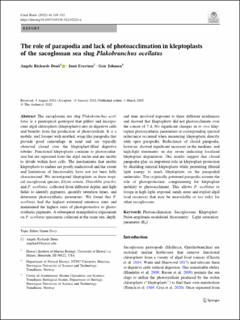| dc.contributor.author | Dona, Angela | |
| dc.contributor.author | Evertsen, Jussi | |
| dc.contributor.author | Johnsen, Geir | |
| dc.date.accessioned | 2023-11-27T08:34:23Z | |
| dc.date.available | 2023-11-27T08:34:23Z | |
| dc.date.created | 2022-03-07T08:22:19Z | |
| dc.date.issued | 2022 | |
| dc.identifier.citation | Coral reefs. 2022, 41 319-332. | en_US |
| dc.identifier.issn | 0722-4028 | |
| dc.identifier.uri | https://hdl.handle.net/11250/3104708 | |
| dc.description.abstract | The sacoglossan sea slug Plakobranchus ocellatus is a pantropical gastropod that pilfers and incorporates algal chloroplasts (kleptoplasts) into its digestive cells and benefits from the production of photosynthate. It is a mobile, reef forager with mottled, wing-like parapodia that provide good camouflage in sand and are typically observed closed over the kleptoplast-filled digestive tubules. Functional kleptoplasts continue to photosynthesize but are separated from the algal nuclei and are unable to divide within host cells. The mechanisms that enable kleptoplasts to endure are poorly understood and the extent and limitations of functionality have not yet been fully characterized. We investigated kleptoplasts in three tropical sacoglossan species, Elysia ornata, Thuridilla gracilis, and P. ocellatus, collected from different depths and light fields to identify pigments, quantify retention times, and determine photosynthetic parameters. We found that P. ocellatus had the highest estimated retention time and maintained the highest ratio of photoprotective to photosynthetic pigments. A subsequent manipulative experiment on P. ocellatus specimens collected at the same site, depth, and time involved exposure to three different irradiances and showed that kleptoplasts did not photoacclimate over the course of 7 d. No significant changes in in vivo kleptoplast photosynthetic parameters or corresponding spectral reflectance occurred when measuring kleptoplasts directly with open parapodia. Reflectance of closed parapodia, however, showed significant increases in the medium- and high-light treatments on day seven indicating localized kleptoplast degradation. Our results suggest that closed parapodia play an important role in kleptoplast protection by shielding internal kleptoplasts while permitting filtered light energy to reach kleptoplasts on the parapodial undersides. The cryptically patterned parapodia assume the role of photoprotectant, compensating for kleptoplast inability to photoacclimate. This allows P. ocellatus to forage in high-light, exposed, sandy areas and exploit algal food resources that may be unavailable or too risky for other sacoglossans. | en_US |
| dc.language.iso | eng | en_US |
| dc.publisher | Springer Nature Ltd. | en_US |
| dc.rights | Navngivelse 4.0 Internasjonal | * |
| dc.rights.uri | http://creativecommons.org/licenses/by/4.0/deed.no | * |
| dc.title | The role of parapodia and lack of photoacclimation in kleptoplasts of the sacoglossan sea slug Plakobranchus ocellatus | en_US |
| dc.title.alternative | The role of parapodia and lack of photoacclimation in kleptoplasts of the sacoglossan sea slug Plakobranchus ocellatus | en_US |
| dc.type | Peer reviewed | en_US |
| dc.type | Journal article | en_US |
| dc.description.version | publishedVersion | en_US |
| dc.source.pagenumber | 319-332 | en_US |
| dc.source.volume | 41 | en_US |
| dc.source.journal | Coral reefs | en_US |
| dc.identifier.doi | 10.1007/s00338-022-02224-z | |
| dc.identifier.cristin | 2007895 | |
| dc.relation.project | Norges forskningsråd: 223254 | en_US |
| cristin.ispublished | true | |
| cristin.fulltext | original | |
| cristin.qualitycode | 1 | |

